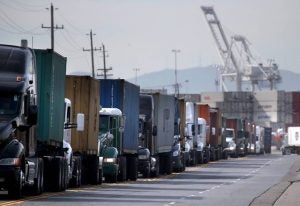Business Sectors
Air pollution is bad for business

Nearly every business contributes to air pollution via operations and supply chains. Common sources include the emissions from burning fuels used to heat buildings, emissions from cooking, and harmful gases released via distribution and delivery vehicles.
It’s not just our health that suffers: air pollution costs the global economy $225 billion each year in lost labor income. Pollution and traffic congestion can disrupt daily business operations, while a recent study showed that “poor outdoor air quality is likely to have a negative impact on your job performance, even if you work indoors at a desk.”
Poor air quality poses a risk to employee health, too, which can lead to more sick days. Air pollution in central London, for example, has been shown to cause the equivalent of over 650,000 sick days each year.
Pollution can also affect profits: a Yale study found that Spanish consumers spend nearly $50 million less on days when ozone pollution is even just 10% worse than usual.
Electrifying trucks and buses will reduce the toxic pollution people breathe from diesel-emitting tailpipes.
The transportation sector is on the cusp of massive change, and one segment within it is ripe for reinvention: medium- and heavy-duty vehicles. These include everything from semi-trucks and delivery vans, to city buses and garbage trucks — the overwhelming majority of which are powered by diesel engines.
Electrifying this segment was an opportunity for lasting change before the COVID-19 economic crash. Now that countries are considering where to invest to rebuild their economies, it’s an opportunity we can’t afford to miss.
Zero-emission vehicles currently comprise a negligible share of the truck market, but they possess the potential to be the workhorses of a clean energy future. They can also help reduce the toxic pollution people breathe in from diesel-emitting tailpipes. Approximately 30 to 45% of the urban population in North America lives “next to a busy road” — and children who live or go to school near major roadways are at considerable additional risk for substantial deficits in lung function, even in areas with low regional pollution.
Globally, climate emissions from large vehicles are on pace to double in the next 30 years, when we must be driving down net emissions to zero. To reverse this trend and transform large vehicles into a critical part of a 100% clean economy, the global fleet must complete a near-total transition to zero-emission trucks and buses. The U.S., China and Europe — as the largest truck markets — must lead the way to this transition by 2050. Read more from EDF Energy Exchange.

Transparency, tech, data will soon tie air pollution back to brands
These days, technology for sensing air pollution is more available to citizens, cities and companies, and new innovations are coming to market almost daily. Open source data analytics is also democratizing insights. Using these technological advancements, local hotspots can already be detected, and soon the health and economic impacts from air pollution will be traced to fleets and specific locations.
This means taking action now to better understand a company’s air pollution footprint can give that business a competitive edge in accelerating solutions (we need to measure before we can manage). The good news is that hyperlocal air pollution insights already being collected in places like Oakland, Houston and London can have myriad benefits. For example, block-to-block information on air quality could inform where electric vehicles would provide the greatest return on investment for health and the climate.
Tackling air pollution is a two-for-one in meeting corporate sustainability targets
Many business leaders have made commitments to prevent climate catastrophe and set clear science-based emissions reduction targets all of which is especially important in light of last month’s IPCC report findings.
Seeing as many sources contributing to climate change are also sources of air pollution (transportation, building operations, etc.), targeting health and climate co-benefits together is a way to set priorities, build support and momentum, and demonstrate impact faster. Investing in solutions to address air pollution would also help the climate and who in business doesn’t love a two-for-one deal?
Read more at “3 Reasons Why Air Pollution Should Be a Top Priority for Business” by Aileen Nowlan, Senior Manager of EDF+Business.
-
COMING SOON to GlobalCleanAir.org: Clean Air Solutions for Business and Industry Sectors
